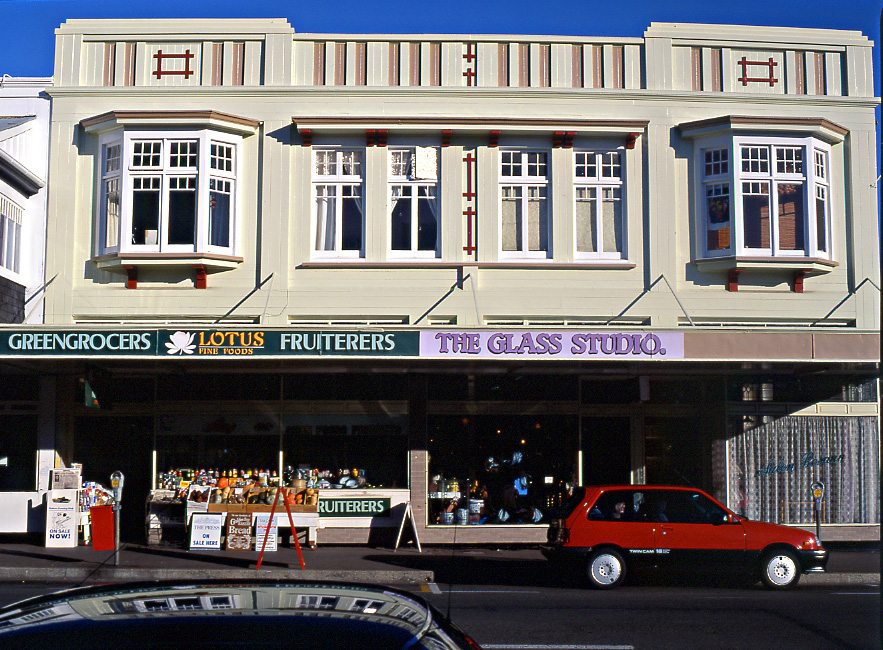274-278 Hardy Street is comprised of parts built in 1891 and 1931. It has historic significance through its connection with notable Nelson businesswoman Sophia Anstice (1849-1926) and prolific local architect A.R. Griffin (1883-1967), who contributed much to the look of Nelson before the Second World War. It possesses architectural significance as a late-era colonial building modernised by a 1931 façade. Māori have occupied the Nelson region since the 1300s. The city was founded as a New Zealand Company town, with the first Pākehā settlers arriving in 1842. The land purchase was marred by controversy - the Company’s claim that it included the Wairau Valley was contested by Ngāti Toa and survey attempts resulted in the Wairau affray, in which 22 Pākehā and at least four Māori were killed. Though Nelson was proclaimed a city in 1858 it remained relatively small throughout the nineteenth century. Dressmaker Sophia King (later Anstice) arrived in Nelson in 1878 and became the family breadwinner after her husband developed tuberculosis. She purchased land on the corner of Hardy and Hope Streets in 1891 and had a dressmaking shop built by Andrew Brown the same year. Anstice retained the name ‘St Albans House’, which she had used in previous locations, and the business flourished, enabling her to open branches in other towns. By 1897 the business had outgrown the Hardy Street shop and she relocated to a larger building in Trafalgar Street. In 1901 Anstice sold the shop to Agnes Moore, who let it out, including to fruiterer D.M. Chapman. In 1929 solicitors Edward Moore and Philip Moore purchased the shop and the vacant lot next door and engaged leading Nelson architect Arthur Reynolds Griffin to design an extension to the existing building with a new street-facing façade. The building doubled in size and now contained three ground-floor shops and two dwellings above. Born and raised in Nelson, Griffin trained in architecture via the International Correspondence School based in the United States. His work was diverse and prolific, including the Nelson Institute (1911; List No. 1603) and the Church Steps (1913; List No. 253), funded by Griffin’s patron, Thomas Cawthron. He designed Nelson’s Plunket and Rest Rooms (1936; List No. 5169) and a host of commercial buildings. He was also successful in winning a number of design competitions, notably Hokitika’s Carnegie Free Public Library (List No. 1702) completed in 1908. Many of Griffin’s commercial buildings are in keeping with the popular stripped classical style of the interwar period. However the shops are a different mix of architectural styles. The tall oriel windows, exposed corbels, and leaded windows suggest a combination of Edwardian Queen Anne and Arts and Crafts styles, with a nod to the quintessential New Zealand bay villa. His use of this hybrid style may reflect the influence of Wellington architects Crichton & McKay as well as his overseas training. The shops have not been significantly altered since the 1931 makeover, aside from the 2018 creation of café space in the service room on the Hope Street side.


Location
List Entry Information
Overview
Detailed List Entry
Status
Listed
List Entry Status
Historic Place Category 2
Access
Able to Visit
List Number
1610
Date Entered
11th November 1982
Date of Effect
11th November 1982
City/District Council
Nelson City
Region
Nelson Region
Extent of List Entry
Extent includes the land described as Pt Sec 437 City of Nelson (RT NL70/46) and Legal Road, Nelson Land District, and the building known as Shops thereon, including the verandah.
Legal description
Pt Sec 437 City of Nelson (RT NL70/46) and Legal Road, Nelson Land District.
Stay up to date with Heritage this month
